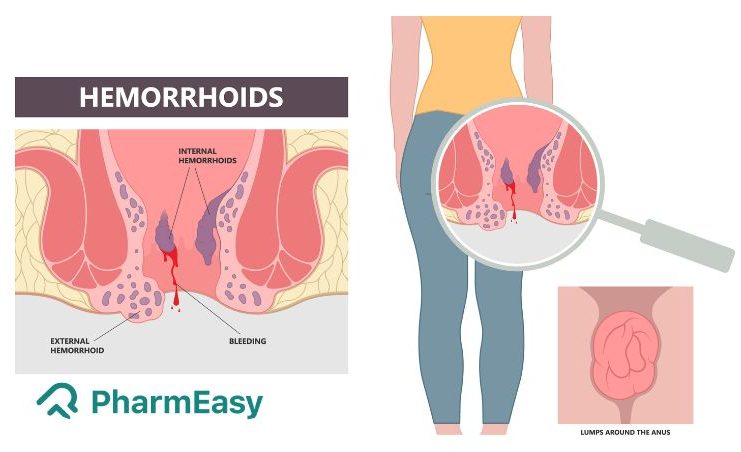Easy Ways To Remove External Haemorrhoids At Home
By Dr. Mayuri Pandey +2 more

Get,

to manage your symptom
Get your,


4 Cr+ families
benefitted

OTP sent to 9988776655



You’ve successfully subscribed to receive
doctor-approved tips on
Whatsapp

Get ready to feel your best.

Hi There,
Download the PharmEasy App now!!


Register to Avail the Offer
Send OTPBy continuing, you agree with our Privacy Policy and Terms and Conditions

Hi There,
Sign up on PharmEasy now!!
Trusted by 4 crore+ families

OTP sent to 9988776655



You have unlocked 25% off on medicines




Code: NU25
By Dr. Mayuri Pandey +2 more
Table of Contents
External haemorrhoids are a common condition affecting the general population. In India, haemorrhoids are known to affect nearly 40 million people, the true incidence remains unknown because of a tendency to self-medicate and not seek proper consultation. Haemorrhoids are swollen and enlarged veins in the anal region, that can be internal or external haemorrhoids. After the age of 45-65, both sexes have an equal risk of haemorrhoids. The number of deaths reported with haemorrhoids is low but it can have a high impact on quality of life.1
Following are the signs noticed by the doctor in people with external haemorrhoids:

Following are the symptoms that you may experience if you have an external haemorrhoid:
Consulting a proctologist is a must as sometimes removing external hemorrhoids can lead to very large amounts of bleeding which is dangerous.
Dr. M.G. Kartheeka, MBBS, MD(Pediatrics)
If you have any of the above complaints, you should seek an expert opinion.
Increased intra-abdominal pressure due to chronic constipation may exert pressure on the tissues present in the anal canal, resulting in swelling and enlargement of the veins.2
External hemorrhoids may develop an inflammation and may recur if left untreated or treated improperly, consultation with a physician is very crucial in such scenarios.
Dr. Ashish Bajaj, M.B.B.S., M.D. in Clinical Pharmacology and Toxicology
Your doctor will take a detailed history and thorough physical examination to confirm piles. Physical examination may help reveal a tender, purplish nodule, skin tags which are suggestive of an external haemorrhoid. To rule out other causes of bleeding, your doctor may do a digital rectal examination.
Your physician will observe you in a prone-jack knife position. This will require you to sleep in a prone position i.e. sleep on your stomach with your head and legs lowered while your hips will be elevated for examining the rectal region.
Read More: 8 Best Home Remedies For Piles
Treatment of external haemorrhoids includes conservative management which includes dietary and lifestyle modifications, behavioral changes and local treatments. The basic goal is to avoid constipation and thus straining and pressure associated with stools. Following are the general recommendations:
Moderate exercises like yoga, brisk walking, swimming for 20-30 minutes a day to help improve bowel function and keep your bowel smooth. Avoid sitting immediately after having food.
If conservative management does not help for treatment of haemorrhoids, non-operative procedures may be recommended by your doctor. If still the symptoms do not resolve, surgical excision of the haemorrhoids may be needed.
Although many medicines are available over-the-counter in medical stores, you should not self-medicate, it is not safe to treat external haemorrhoids at home. You should avoid external haemorrhoids cure at home and consult your doctor for proper management of haemorrhoids.
External hemorrhoids are a type of hemorrhoid that develops outside the anus, usually under the skin around the anal opening. They occur when the veins in the anal area become swollen and inflamed, causing bleeding, pain, and itching. It is best to consult a doctor for proper treatment of piles and avoid self-medication.
Haemorrhoids which are found on the outside skin near the anal region are called as external haemorrhoids.1
Although, conservative management of external haemorrhoids at home is recommended by doctors, it is always best to consult a doctor to assess the severity of the condition and treat it accordingly.
Pain with bowel movements, itching and burning sensation near the rectum and anal region, bleeding associated with the bowel movements, ulceration near the anal region and reduced appetite are the symptoms of external haemorrhoid.2
For external haemorrhoids, many different local treatment options are available which include sitz bath, use of ice-packs for topical application etc.3,5
There is no such treatment which will help you to cure or remove haemorrhoids in one day at home. Hence, you should consult a doctor at the earliest stage when you experience any complaints or symptoms which have been discussed above already and get them treated at the earliest.
Disclaimer: The information provided here is for educational/awareness purposes only and is not intended to be a substitute for medical treatment by a healthcare professional and should not be relied upon to diagnose or treat any medical condition. The reader should consult a registered medical practitioner to determine the appropriateness of the information and before consuming any medication. PharmEasy does not provide any guarantee or warranty (express or implied) regarding the accuracy, adequacy, completeness, legality, reliability or usefulness of the information; and disclaims any liability arising thereof.
Links and product recommendations in the information provided here are advertisements of third-party products available on the website. PharmEasy does not make any representation on the accuracy or suitability of such products/services. Advertisements do not influence the editorial decisions or content. The information in this blog is subject to change without notice. The authors and administrators reserve the right to modify, add, or remove content without notification. It is your responsibility to review this disclaimer regularly for any changes.

Leave your comment...
Comments